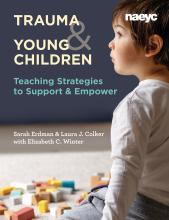Trauma and Young Children: Teaching Strategies to Support and Empower

About the Book
-
What trauma is, what causes it, and its potential effects on the brain and learning
-
Why your relationships with children and families are critical to promoting healing
-
How to create trauma-informed programs and implement practices that support children and families
-
How to care for your own well-being
Table of Contents
- Preface
-
Chapter 1: Introduction
- Why It Is Important to Understand Trauma
- Prevalence of Trauma
- Trauma-Informed Care
- Early Childhood Educators Matter
- A Path Forward
-
Chapter 2: Types of Trauma Experienced by Young Children
- What Is Trauma?
- Key Concepts Related to Trauma
- Adverse Childhood Experiences
- Causes of Trauma
- Category 1: Household and Family
- Category 2: Loss
- Category 3: Family Separations
- Category 4: Violence and Disasters
- Post-Traumatic Stress Disorder
- Role of Racism in Trauma and Child Well-Being
- The Influence of Other Factors on Children’s Experiences of Trauma
- Responses to Trauma Are Individual
- A Path Forward
-
Chapter 3: How Trauma Impacts Young Children’s Brains and Their Ability to Learn
- Brain Circuits and Connections
- Experience and Brain Connections
- Responding to Stress
- The Impact of Trauma on Development and Learning
- What Toxic Stress Looks Like in Early Childhood Programs
- A Path Forward
-
Chapter 4: Guiding Principles for Teaching Children with Trauma
- Principle 1: Recognize that All Children Will Benefit from a Trauma-Informed Approach
- Principle 2: Use a Strengths-Based Approach to Teaching
- Principle 3: Recognize, Appreciate, and Address Differing Influences on Children’s Experiences with Trauma
- Principle 4: Embrace Resilience as a Goal for Every Child
- Principle 5: Help Children Learn to Regulate Their Emotions
- Principle 6: Use Positive Guidance When Dealing with Children’s Challenging Behaviors
- Principle 7: Be a Role Model to Children on How to Act and Approach Learning
- Principle 8: Help Children Turn Negative Thinking Around
- Principle 9: Enrich the Children’s Lives with Art, Music, and Dance
- Principle 10: Look Beyond Children’s Traumas and Celebrate the Joys in Life
- Principle 11: Remember that You Don’t Have to Have All the Answers
- A Path Forward
-
Chapter 5: Establishing a Safe and Inviting Environment for Learning
- Design a Physical Environment that Supports Children’s Emotional, Social, Physical, and Learning Needs
- Provide Materials that Support Learning and Healing
- Bring Structure to the Environment Through the Daily Schedule
- Tips for the Physical Environment
- A Path Forward
-
Chapter 6: Connecting with Children
- How to Foster Relationships When Children Have Experienced Trauma
- Help Children Form Strong Friendships with Their Peers
- Mindfulness As a Tool For Building Relationships and Other Needed Skills
- Tips for Interacting with Children
- A Path Forward
-
Chapter 7: The Healing Power of Play
- Benefits of Play When There Is Trauma
- A Right to Play?
- The Impact of Trauma on Play
- Using Play to Address Trauma’s Negative Effects
- Using Playful Learning with Children Who Are Distressed
- When Violence Is a Part of Play
- Tips for Using Children’s Play as a Healing Agent
- A Path Forward
-
Chapter 8: Partnering with Families
- What Is a Family?
- What Is Engagement?
- Special Considerations in Working with Families of Children Who Have Experienced Trauma
- Connecting with Families to Benefit Children
- A Path Forward
-
Chapter 9: Trauma-Informed Care in Schools and Communities
- TIC and the School Community
- The Four Rs Framework and Six Principles of TIC
- What TIC Looks Like in Action
- Working with Your Administrator
- Advocacy
- A Path Forward
-
Chapter 10: Caring for Yourself
- Your Own Compounding Stress
- Defining Teaching-Related Stress
- Using Self-Care to Overcome Secondary Trauma
- A Path Forward
- Appendix One: Resources for Educators
- Appendix Two: Picture Books About Trauma
- Appendix Three: Handouts for Families
- References
- Index
- Acknowledgments
- About the Authors
Book Details
ISBN: 978-1-938113-67-3
Publish Date: 2020
Related Resources
Articles
"Building Resilience: Helping Children Cope with Violence in Their Communities" - In this article, Jennifer R.M. Hill and Regina M. Adesanya discus how childhood educators can reduce the impact of community violence by helping to build children’s resilience. (Young Children, September 2019)
"The Calm in the Storm: Supporting Young Children before, during, and after a Community Disaster or Trauma" - Julia Yeary discusses how educators can meet infants and toddlers emotional needs in a disaster. (Young Children, November 2018)
Webinars
"Creating Trauma Sensitive Classrooms" - Presented by Barbara Sorrels and Katie Statman-Weils, this webinar identifies behavioral signs that children dealing with trauma may exhibit, as well as effective strategies that can be used to create trauma-sensitive classrooms.
Sarah Erdman is an experienced early childhood educator and museum professional in Northern Virginia. She teaches at FB Meekins Cooperative Preschool. [email protected]

Laura J. Colker, EdD, is president of L.J. Colker & Associates, in Washington, DC. She is an author, a lecturer, and a trainer in early childhood education with 40 years of experience. [email protected]

Elizabeth C. Winter, MD, is a board-certified psychiatrist in Baltimore, Maryland. She is a senior physician with the Department of Veterans Affairs, Office of the Inspector General and a faculty member of the Johns Hopkins Hospital Department of Psychiatry and Behavioral Sciences.

Reviews
The power of Trauma and Young Children: Teaching Strategies to Support and Empower comes from its strength-centered principles and the hundreds of practical activities that translate these principles into action. This book can be your go-to source on using a healing-centered approach to trauma for years to come.
—Ellen Galinsky, Author of Mind in the Making: The Seven Essential Life Skills Every Child Needs
This comprehensive resource could not be more timely. Increasingly, early childhood educators must understand and know how to address the effects of traumatic experiences on young children’s well-being and ability to learn. The authors have given us the what, why, and how of trauma-informed teaching to empower us to respond in positive, constructive ways to help all children thrive.
—Diane Trister Dodge, Early Childhood Curriculum Specialist and Founder, Teaching Strategies, LLC
The authors provide specific strategies to mitigate and buffer the effects of toxic stress on young children. These practical application techniques are precisely what teachers need.
—Christine Schull, Professor of Early Childhood Development, Northern Virginia Community College Alexandria
Early childhood educators are not therapists, so what specifically can we do to implement trauma-informed care? Start by reading this excellent presentation of strategies that support and empower children. This book is a useful blend of the field’s foundational developmentally appropriate practice principles applied to the best of what we know about trauma-informed care.
—Valora Washington, CEO, The CAYL Institute
Trauma-informed care is now an absolutely essential component of developmentally appropriate practice for all children, teachers, and early education programs. Grounded in the science of child development, this important book provides effective strategies for supporting the healthy development of every child and teacher during the most challenging and stressful times in recent history.
—Sue Bredekamp, Early Childhood Education Consultant and Author
An invaluable resource for all who work with young children and their families, this book offers detailed guidance on how to recognize the impact of childhood trauma, work with experts to turn fearful situations into hopeful outcomes, and maintain your own health, sense of well-being, and optimism.
—E. Dollie Wolverton, Retired Chief of Education, Head Start Bureau
Early childhood educators are seeking to better understand the effects of trauma on the development of children and asking for concrete strategies to support them. This wonderfully written book addresses that need in a clear and compassionate way.
—Whitcomb Hayslip, Early Childhood Education Consultant and former Assistant Superintendent for ECE, Los Angeles Unified School District
Trauma and Young Children clearly lays out why and, more important, how all early learning programs can benefit from incorporating a trauma-informed approach. It offers an important set of tools for early educators to meet children where they are.
—Meredith Downing, Manager of Learning, Wonderschool
